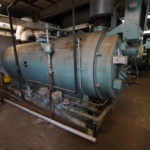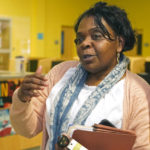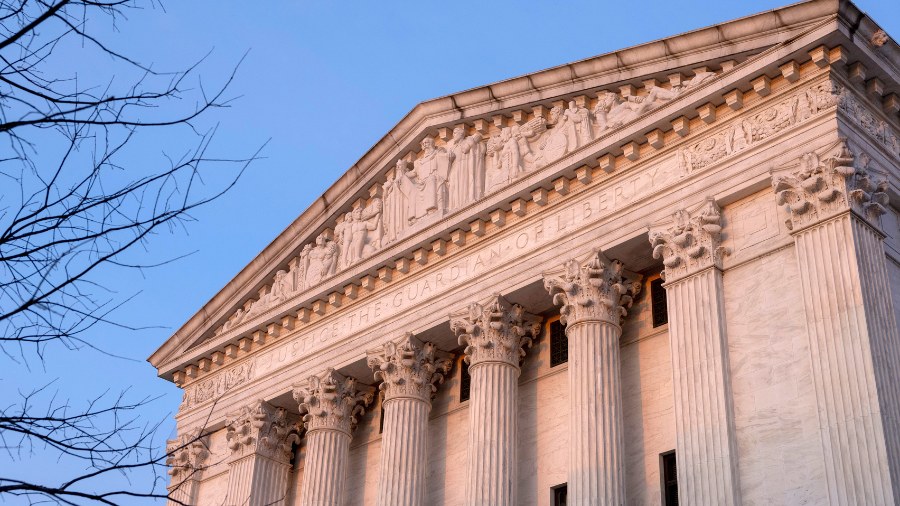For poor schools, building repairs zap COVID relief money
Feb 19, 2023, 4:10 PM | Updated: Feb 20, 2023, 6:57 am

Jim Hill High School principal Bobby Brown, points out one of the outdated air-condition units that are installed throughout the Jackson, Miss., school, Jan. 12, 2023. A litany of infrastructure issues in the nearly 60-year-old school make for tough choices on spending COVID recovery funds on infrastructure or academics. (AP Photo/Rogelio V. Solis)
(AP Photo/Rogelio V. Solis)
JACKSON, Miss. (AP) — The air-conditioning gave out as students returned from summer break last year to Jim Hill High School in Jackson, Mississippi, forcing them to learn in sweltering heat. By Thanksgiving, students were huddling under blankets because the heat wasn’t working.
Along the way students dealt with broken showers in locker rooms, plumbing issues and a litany of other problems in the nearly 60-year-old school building.
“There’s been times we’ve been cold, there’s been times we’ve been hot,” said Mentia Trippeter, a 17-year-old senior. “There’s been times where it rained and it poured, we’ve been drowning. We go through it — we go through it, man.”
Like other schools serving low-income communities across the country, Jim Hill has long dealt with neglected infrastructure that has made it harder for students to learn. So when Jackson Public Schools received tens of millions of dollars in federal COVID relief money, it decided to put much of the windfall toward repairing heating and plumbing problems, some of which temporarily caused the school to switch to remote learning.
For poorer school districts, deciding what to do with that money has involved a tough tradeoff: work on long-term academic recovery or fix long-standing infrastructure needs.
All told, the federal government has allocated $190 billion in pandemic relief aid to help schools recover — more than four times the amount the U.S. Education Department spends on K-12 schools in a typical year, and with few strings attached.
An Associated Press analysis of school district spending plans from across the country found that the poorest districts in each state are far more likely than the richest districts to spend emergency relief funds on upgrading their buildings or transportation systems.
Jackson’s academic needs are no less pressing. The majority of students in the district learned virtually for a year and a half during the pandemic and math test scores plummeted by the equivalent of over a full year’s worth of learning, according to Harvard and Stanford’s Education Recovery Scorecard. But school officials didn’t want to miss a rare opportunity to fix infrastructure issues — some of which date back decades.
William Merritt, the school district’s chief of staff, said the funds gave the district the ability to “provide our students with tools that other students in well-to-do districts have.”
The data in AP’s analysis came from education market research firm Burbio, which reviewed how more than 6,000 districts across the country, representing over 75% of the nation’s public school students, planned to spend their federal relief money. The data covered the final and largest round of federal aid to schools, totaling $122 billion.
The AP found that school districts with the highest percentage of children living in poverty — the poorest 20% of districts in each state — were more than three times as likely as the wealthiest school districts to dedicate money to the construction of new buildings or classrooms. School districts with high levels of poverty were also more than twice as likely to include money for facilities repairs.
“The poor districts are doing it because they’re chasing after emergencies,” said Mary Filardo, executive director of the 21st Century School Fund.
Infrastructure is a prime example of long-standing inequities in school funding. While affluent districts can rely on local tax revenue to pay for major improvement projects such as installing state-of-the-art heating and ventilation systems, poorer districts that cannot often spend more money over time on short-term fixes.
In Texas, the Victoria Independent School District is also grappling with competing infrastructure needs and pandemic recovery. It plans to spend half of the $28.4 million it received in the last round of relief funds on academics, teacher retention and student supports that include social-emotional behavior specialists.
But the other 50% of the money is devoted to improving air quality, such as updating ventilation systems. Superintendent Quintin Shepherd says he’d love to spend more on counselors and less on fixing broken air conditioners, but there’s no way kids can learn safely in a classroom that’s 100 degrees Fahrenheit (38 degrees Celsius).
“We got into education to improve educational outcomes and life expectations. It’s a hard position to have to make these impossible decisions,” Shepherd said.
Some have argued the money shouldn’t be spent on infrastructure projects, which can take years to complete and often with with no immediate benefit to students. But the government only required 20% of the emergency relief funds to be spent addressing learning loss.
U.S. Education Secretary Miguel Cardona said in a recent speech that the relief funding was “intended to accelerate reopening and recovery, not to fill decades of underinvestment in education funding and support for students.”
Marguerite Roza, director of the Edunomics Lab at Georgetown University, said it was right for the government to allow a high degree of flexibility in how to spend the relief funds, rather than bogging districts down in red tape.
In Jackson, officials chose to spend over half of the $109 million the district received in the last round of federal funding on fixing the facilities in schools like Jim Hill.
Students at the school generally agreed that it needed infrastructure upgrades. Still, when asked what they would do if they were put in charge of spending that money for the district, some had bigger wishes.
“I believe we could hire more teachers to teach different types of subjects,” said Elijah Fisher, a 17-year-old junior. But, he admitted, first he would use the money to fix the drainage system around the school.
Overall, officials in Jackson are confident that they’re making the right investment.
Though much of the funding went toward infrastructure needs, the school district also bought laptops for every student and invested in after-school programming. Jim Hill now offers near year-round school with the summer term devoted to field trips and “learn by doing” experiences.
The school’s principal, Bobby Brown, said the money spent on infrastructure needs is very necessary — although not enough to address decades of inequity in the majority Black school system.
“As you listen to the students, and them having generations of families that have similar experiences,” Brown said, “this also sheds light on the types of investment that we have — or the lack of investment that we have in communities where people look like us.”
___
The Associated Press education team receives support from the Carnegie Corporation of New York. The AP is solely responsible for all content.
Copyright © The Associated Press. All rights reserved. This material may not be published, broadcast, rewritten or redistributed.























